Do-it-yourself storm water drain: all about the installation of a storm shower for a summer house and a private house
Sometimes for a summer resident, the long-awaited rain at the height of the season becomes a real natural disaster. As a result of a prolonged summer rainfall, as during the spring flood, a real lake can form on the site.
In order to avoid stagnation of water, a collection and removal system from the territory is needed. If you build a storm sewer with your own hands, then the cost of its construction will be minimal.
The article presented for familiarization sets out in detail the principle of the design of an atmospheric water drainage system, describes the components of the structure. We will tell you how to build it better and how to maintain it. Given our advice, the organization of stormwater will not cause the slightest difficulty.
The content of the article:
Storm drain options
Storm sewage - a specific design. In the water discharged through this system, there is both small and large debris. Therefore, in the storm must be primary treatment.
The system may differ in the amount of water that it is able to accept, design, duration of effective functioning.
Based on the system device, one can distinguish 3 types of stormwater:
- Open. It has the simplest design, easy to execute, and is inexpensive.
- Closed. This option is more complicated. Here you have to deal with underground pipes, storm water inlets. The system needs to be planned in advance, and installation is better done by a specialist.
- Mixed. Choose when there is not enough finance to implement option 2, and also if you need to cover a large area. It is something between the first two.
Storm sewage of the first type is performed in the form of drainage trays built into the coating. According to them, water enters a specially designated place or simply merges into the garden. The system of the second type is located below the zero point, which involves excavation in a considerable amount and the corresponding financial investments.
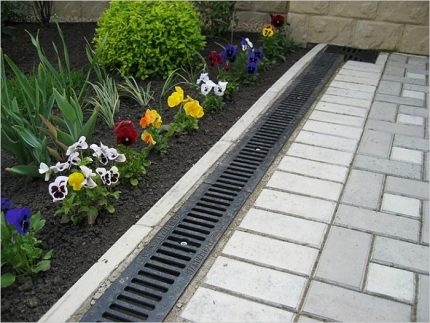
Equipped with such a storm mainly during the development of the site, since this is a simpler freezing version. They deepen the system not very deep - up to a meter maximum, but both in winter and early spring it is not involved in the work.
So that the sewage system does not freeze, pipes are buried below the freezing point. With the third type of stormwater, the elements of the sewage system are partially located both on top and in the soil.
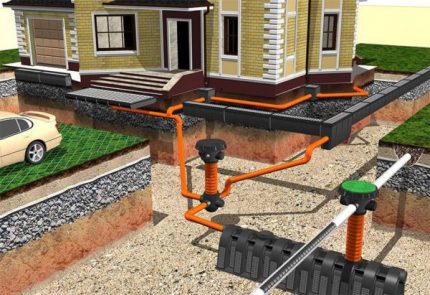
Design of a storm shower is always individual. It is unlikely that there are sites with absolutely similar conditions. They will always differ ‚if not with relief‚ then with layout ‚soil properties‚ number of outbuildings.
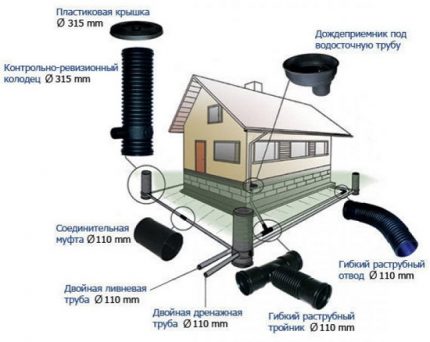
The main elements of the classic sewer
Storm sewage can be point and linear. The first option involves collecting water from non-moisture-absorbing surfaces, such as roofs, paved areas. In the future, the effluents go to the receiving tanks, and after that they enter the drainage system.
With the linear method of discharging wastewater, the water is drained into trays located at paths and platforms. A simplified version of storm sewers consists of the following elements:
- a central pipe, laid under a layer of earth and finishing coat and leading the collected water to the extreme point of the scheme;
- trays - the main part of the system transporting excess water to sand traps ‚the efficiency of the drainage system largely depends on them;
- a storm water inlet located under a pipe or at a low point in the yard to collect liquid;
- filters and distributors - invisible, but extremely responsible components.
All elements included in the system are equally important. If any of them fails, the efficiency of the entire structure decreases.
Types of storm water inlets for sewage
The purpose of the storm water inlet is to collect moisture coming from pipes, yard cover. This element first takes over the entire volume of water coming from the drainpipes. When choosing a storm water inlet, they are guided by such data as the average amount of precipitation, their intensity, topography, and the area occupied by storm sewers.
You can buy a storm inlet pig-iron or plastic. The former are preferable in case of heavy loads, and the latter attract moderate cost, light weight, simplifying installation. A cheaper option is to make a storm water inlet for storm sewers in your summer house from brick yourself.
The walls of the pit are faced with brick, leaving a hole for the pipe, then plastered from the inside. And even better - leave a gap between the wall of soil and the cover and fill it with concrete. The bottom of the storm water inlet must be concreted.
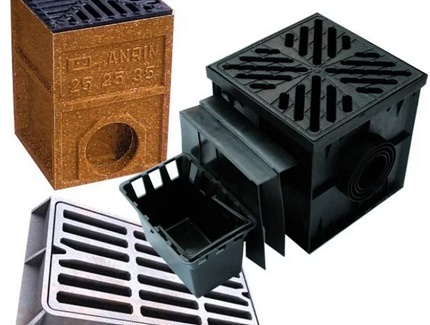
This important element is also made of concrete rings. Then the bottom ring can be purchased with a finished bottom and you do not have to fill the plate. Sometimes factory storm water inlets come on sale complete with a basket, siphon, decorative grille.
Most often used for private construction, storm water inlets made of plastic or composite materials are produced in the form of a cube, each side of which is 30 -40 cm. There are adapters for inserting pipes from below and from all sides of the product.
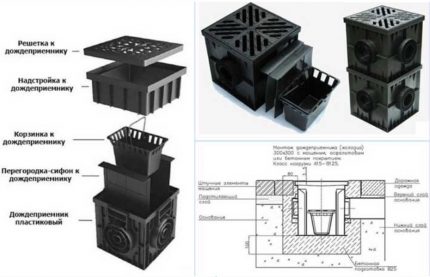
In order not to clog the pipes with debris falling through the lattice cells, the storm water inlets are equipped with baskets. As soon as they are full ‚they are taken out and cleaned, then returned to the place.
The design of the factory storm water inlet provides partitions dividing its internal space into compartments and creating a water lock. As a result, the unpleasant odor from decomposing organic matter does not penetrate outward.
The efficiency of a point storm water inlet depends not only on its volume, but also on the installation location. It must be located under a drain or in a place where moisture constantly collects. If it is installed under the pipe, then the jets must exactly fall into the center of the grate, otherwise part of the water will fall onto the foundation or the coating of the yard in the form of splashes.
Why are sand traps needed?
Rain and melt water in any case contains a certain percentage of insoluble particles.If sand traps are not included in the scheme, dirt will settle in the sewers and it will cease to function in full. Flushing the system is expensive.
A sand trap is a camera installed behind point receivers in places where water is discharged into underground pipes. It is designed so that the flow of water, falling into it, reduces speed.
As a result, under the influence of gravity, the suspended particles sink to the bottom, and the liquid freed from them leaves through a special hole. In shape, the sand trap is a trap with many chambers located horizontally or a chamber in a vertical design.
What are drainage channels?
If blind area around the house has already been completed, but the drainage system has not been taken care of; as a way out of the situation, drainage gutters, which are also called linear storm water inlets, can be used. Channels made of concrete or plastic are laid abroad blinds parallel to the paths and overhangs of the roof with a certain slope.
Water enters the linear drainage channels both from the roof gutters and from the entire yard, covered with asphalt or slabs. Such sewage can cover much more objects than point. When buying ready-made trays, it is necessary to pay attention to such important parameters as the class of permissible load and the tensile strength.
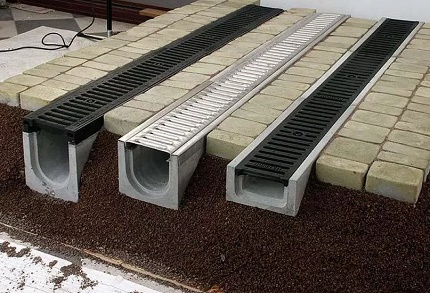
The weakest products are marked A15. This means that their use is permissible with a maximum load of up to 1, 5 tons. They are installed around the perimeter of the house ‚in pedestrian and designated areas for cyclists. Trays of class B125 cope without damage to their integrity with a load of up to 12.5 tons. They will not be damaged by the weight of the car, therefore they are appropriate in the garage area.
For private construction, do not buy massive concrete gutters ‚plastic trays are quite suitable here. They have a strength class A ‚B‚ C. The material for their manufacture is polyethylene or polypropylene.
An important parameter when selecting trays is the hydraulic section, indicated by the abbreviation DN. It must correspond to the diameter of the pipes supplied to these elements. For plastic gutters, the DN value ranges from 70 to 300.
The length of the standard tray is 1 m. The products are equipped with a locking system ‚with its help the gutters can be arranged in 1 line‚ connect them to the pipes or make branches. A rational choice for giving ‚a private house - models from DN100 to DN200.
How to choose pipes?
For storm sewers according to SNiP, you can use pipes made of metal, asbestos or plastic. Most often, for a private house and cottage, the choice is stopped at plastic pipes. They are lightweight ‚decorative‚ do not corrode ‚their installation is simple, but the mechanical strength of the material‚ in comparison with metal ‚is small.
Having chosen the material, you need to determine the diameter of the pipes.
The initial value is the largest volume of discharged rain and melt water. This parameter is determined by the formula:
Q = q20 × F × Ψ
Here: Q is the desired volume ‚q20 is the coefficient‚ characterizing the intensity of precipitation for 20 seconds. (l per second per 1 ha). F is the compound area in ha, if the roof is pitched, the area is calculated on the horizontal plane. Ψ is the absorption coefficient.

Based on the calculated value and using the Lukin's tables, they find not only the diameter but also the slope of the system.
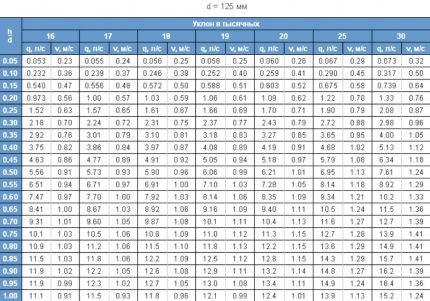
With the correct selection of the diameter of the pipes, storm sewers will cope with the task even at times of the most heavy rainfall. If flows from several gutters enter the pipe, all of them summarize. Practitioners for pipes with a cross section of 110 mm and gutters of the same diameter usually use a slope of 20 mm / linear. M.
If the pipe is connected to the storm water inlet, the slope value is slightly increased to avoid stagnation of the liquid, and when entering the sand trap, the slope is reduced. This slows the movement of the water flow, and suspended particles settle to the bottom in larger quantities.
Water in a sewer system of this type drains by gravity, which is due to the formed drain pipe slope. There are no pressure pumps, so in the country house or in the country compound for the device of storm sewers it is not necessary to look for a team of professionals.
All the work the owner will be able to perform independently. Details of the calculations for the organization of storm sewers are written in article, the content of which we recommend to read.
Where is a well and a collector needed?
As in any system ‚consisting of underground pipes‚ there must be a well in storm sewers.
Installing it is advisable in the following circumstances:
- if 2 or more streams converge;
- when it is necessary to radically change the height of the bed, the direction of the pipeline or its slope;
- when it becomes necessary to switch to a larger pipe diameter.
Wells are also provided for at fixed intervals of straight sections of the system. If the diameter of the well does not exceed 150 mm, then the next is placed at a distance of 30 to 35 m. With a diameter of 200 mm, from 45 to 50 m, and if the diameter is 0.5 m, the interval is increased to 70-75 m.
The diameter of the well of a private house does not exceed 1 m. The deeper the well ‚the larger its diameter should be.
Some owners lay wells in the old fashioned way from brick or reinforced concrete rings.Others prefer more advanced materials - plastic and fiberglass. By design, the wells are collapsible and solid.
They have the shape of a cylinder with a completely sealed bottom and a hole at the top. To connect the pipes there are nozzles. As wells, several assembled storm water inlets are also used.
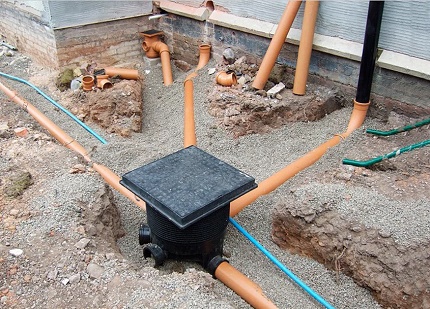
A collector is included in the system to redirect the collected water to a groundwater treatment plant or to a gutter. Sometimes its role is played by a large plastic well. It is converted into a drive by tightly closing the outlet pipes. To use water, use a submersible pump.
Under the collector, pipes of large cross section are also used - reinforced concrete or plastic with the supply of all pipelines to them. On the construction market, you can also purchase a ready-made container for underground use. There are multi-chamber reservoirs where rain and melt water are treated according to the same principle as in septic tanks.
How to install stormwater?
The stormwater is mounted using the same technology as a conventional sewer system. In any case, the design of the storm sewer system is preceded by a calculation ‚selection of the necessary materials. Before getting into the pipes, rainwater is collected on the roof of the house, so it is logical that the construction of the drain begins from the top point of the structure.
For gutter installations on the roof mark the upper and lower points between which pull the fishing line. On this route gutters will be installed taking into account the slope. The direction of their installation depends on the location of the pipes for the drain.
To fix the gutters and pipes, brackets are installed, fixing them with self-tapping screws. In order for water to fall into the drain, funnels are needed at the lower points. Collecting trays and pipes ‚apply sealant to the joints. Sometimes there are factory seals at the edges of the parts, then during their joining a tight connection is obtained.
Water collected from the roof by gutters, through vertical gutters, enters the storm sewer. The series of works on the device of a linear storm shower, regardless of its technical complexity, includes a number of traditional stages, these are:
Precision drainage of rain and meltwater
The first step is the marking of the pipeline ‚consisting of channels‚ receivers ‚wells. Pegs are driven in at the points of arrangement of all elements. A cord is laid between the pegs to see the full picture. The second stage is the digging of the trench and small recesses under the storm water inlets. At the bottom arrange a sand pillow.
If there is a threat of root sprouting in the places where the pipeline is laid, the bottom is covered with geotextiles. The installation process begins the installation of wells ‚collectors.
Further, smaller elements - storm water inlets, sand traps, trays. All this is combined by pipes of the calculated diameter under the slope selected from the table or recommended by SNiP. When laying the pipeline, sagging is unacceptable.
The assembled design is tested. Water is spilled on each section to check the tightness of the joints. The amount of water filled and released should be approximately the same. A defect such as sagging can be detected, as indicated by a significant difference in the volumes of water at the inlet and outlet.
If the tests do not reveal problems, the system is covered with a sand-cement layer and soil. Sometimes some details of storm sewers are combined with a drainage system. At the same time, the pipes must first be on top of the second pipeline, but they can approach one collector.
The combination of storm sewers with ordinary household can not be allowed. This can lead to overloading the second with all the negative consequences.
Let us analyze the construction of storm sewers with point water intake devices as an example. They built it from ordinary sewer pipes. The reason was the stagnation of water on the surface, formed due to the practical absence of infiltration into the ground, associated with the clay structure of the soil.
We assume that we laid the lines properly with a slope, connected the bends to them, observing the tightness of the joints. In this case, tightness is needed not to protect the surrounding soil from rainwater, but to prevent sand from entering the system.
We will continue the work, now it is necessary to connect the stormwater to the pipe leading to the absorbing well:
Storm drain prevention
Having installed the storm sewers of a private house or summer cottage on your own, one should not forget that it needs constant care. Preventive measures include tray cleaning and point storm water inlets from the trash settled in them.
If you neglect this procedure, the system will certainly fail. The ideal option is to use the system all year round.
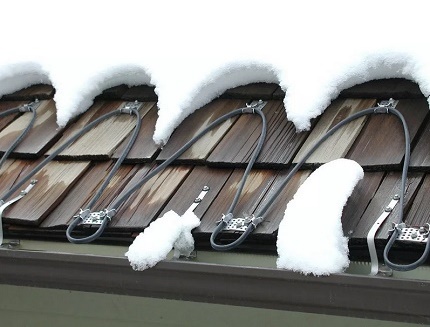
During the cold season, thaws occur, during which water from the channels gutter system. Then she moves into the storm sewer,
where it freezes, it turns into ice.
To prevent the formation of ice caps in stormwater, self-regulating heating cable lead into the storm water inlets located under drainpipes. So in the warming system, ice jams will not be created, and if they are formed, it will be possible to quickly get rid of them.
Conclusions and useful video on the topic
About the purpose ‚the device and the consequences of the malfunction of the storm‚ you will learn from the video:
The installation process of storm sewers will not seem so complicated after viewing this material:
Despite the fact that storm sewage is a complex engineering system, its creation is within the power of even a person who is not burdened with deep knowledge in the construction business.It is worth following all the tips exactly and the storm sewer around a private house will work flawlessly.
Please write comments in the block below. Tell us about your experience in organizing a storm sewer system. Ask questions, share your impressions from reading and useful information for site visitors, leave a photo on the topic.

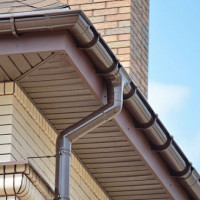 How to make spillways from the roof: general recommendations for arranging a drainage system with your own hands
How to make spillways from the roof: general recommendations for arranging a drainage system with your own hands 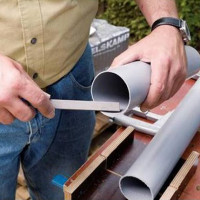 DIY roof gutters: instructions for self-manufacturing a drainage system
DIY roof gutters: instructions for self-manufacturing a drainage system  Calculation of storm sewers: an analysis of important design features
Calculation of storm sewers: an analysis of important design features 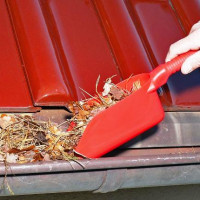 Storm sewer cleaning technology: an overview of popular ways
Storm sewer cleaning technology: an overview of popular ways  Which gutter is better - plastic or metal? Comparative review
Which gutter is better - plastic or metal? Comparative review  How much does it cost to connect gas to a private house: the price of organizing gas supply
How much does it cost to connect gas to a private house: the price of organizing gas supply  The best washing machines with dryer: model rating and customer tips
The best washing machines with dryer: model rating and customer tips  What is the color temperature of light and the nuances of choosing the temperature of the lamps to suit your needs
What is the color temperature of light and the nuances of choosing the temperature of the lamps to suit your needs  Replacement of a geyser in an apartment: replacement paperwork + basic norms and requirements
Replacement of a geyser in an apartment: replacement paperwork + basic norms and requirements
I have a country house by the river, on a slope. And during a downpour from the mountain such an avalanche of muddy water floats on our site, it’s already scary. As I could, I tried to arrange a storm. Of course, he instructed storm water inlets from improvised tanks.
It is good that the underlying soil is not clay, and in normal rain it absorbs everything normally. But in a strong prolonged downpour, it’s just a natural disaster, then for three days there is water in the yard.
We didn’t bother much with this, we simply led to the flowers outside the terrace. In general, our climate is slightly arid, in the summer there is unbearable heat, but it happens that it rains for several days, although it is quite strong, then the flowers and clubs are even slightly washed away by the flow of water. They cleaned it a couple of times, leaves fall and so on, in winter we clear it of snow, because the snow rolls off the roof and weighs heavily on the water intake.